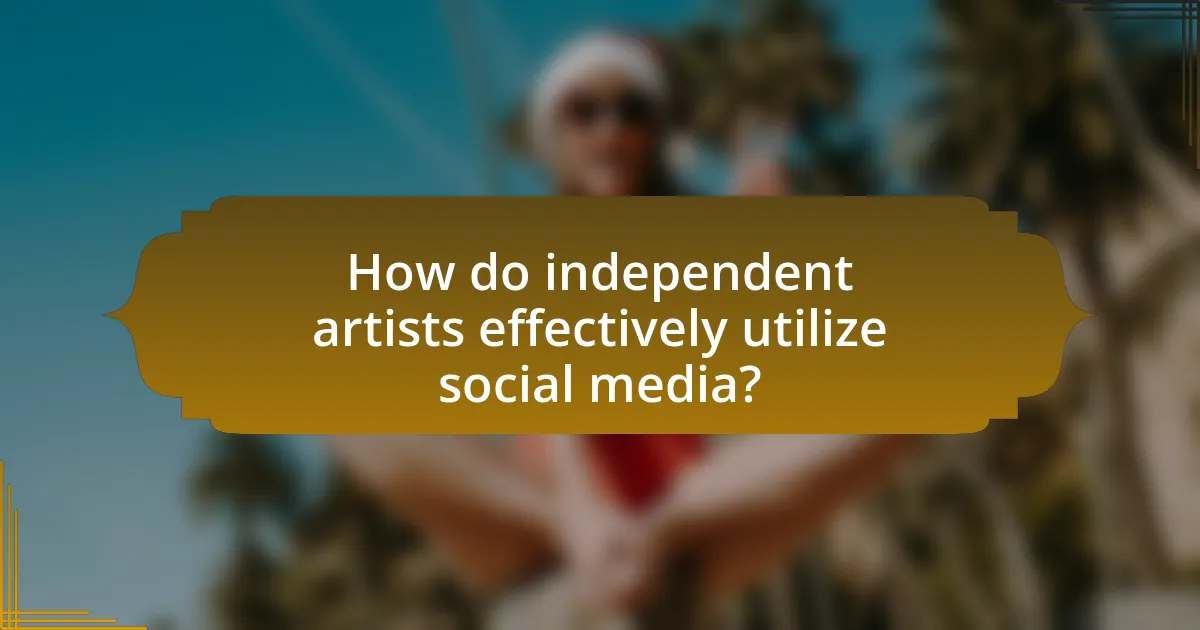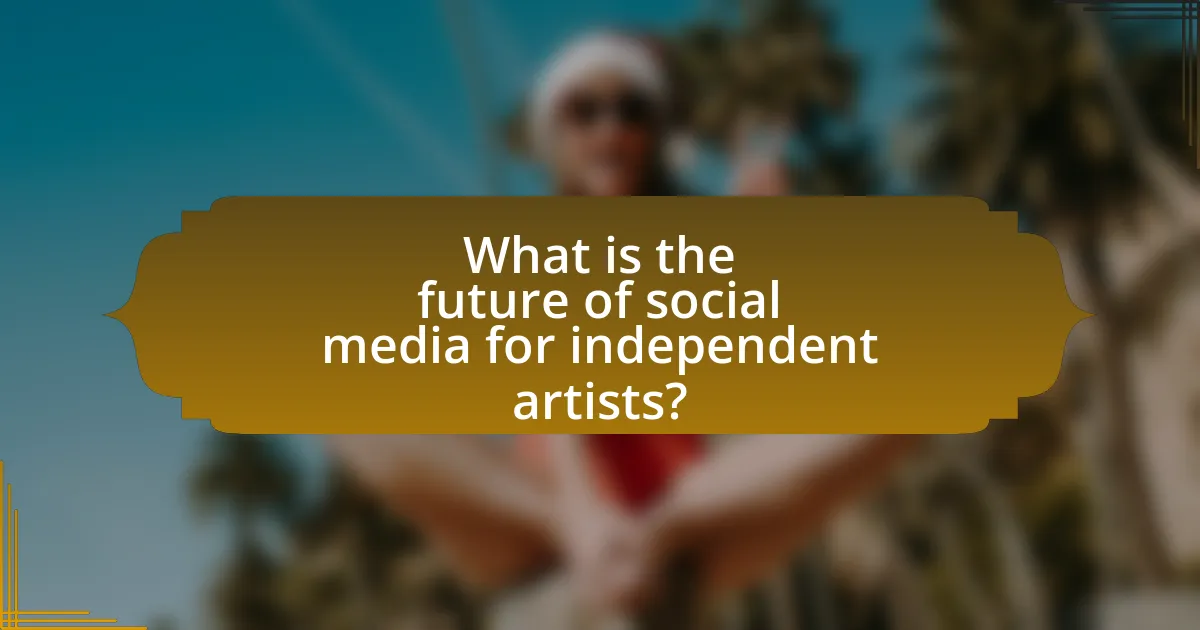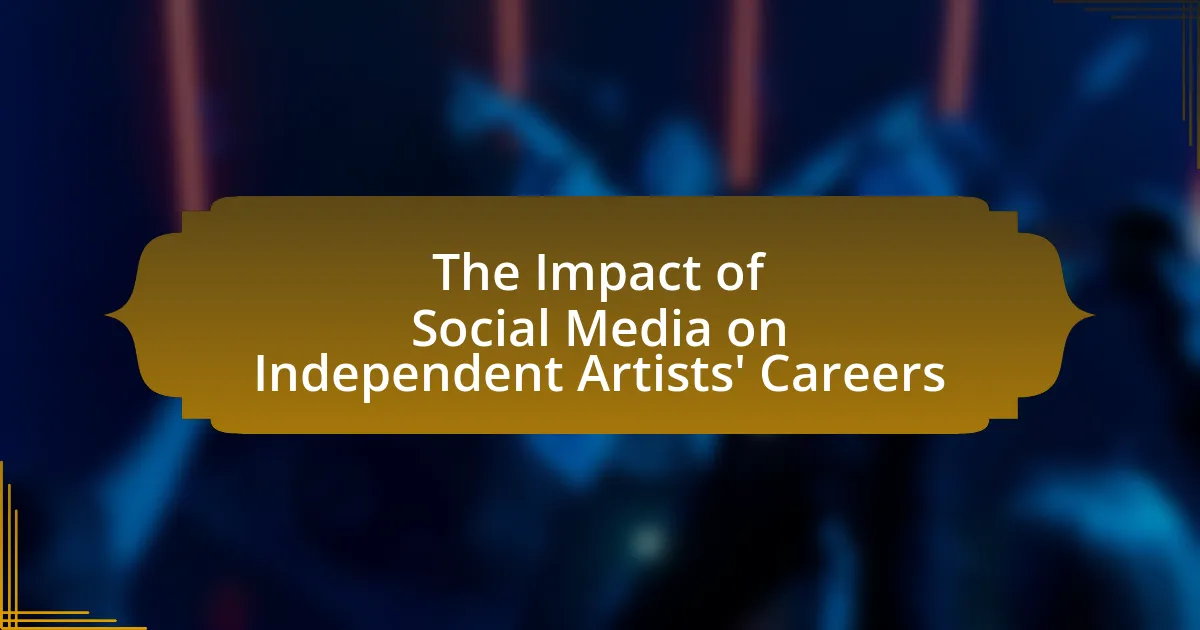The article examines the impact of social media on the careers of independent artists, highlighting how these platforms facilitate direct audience engagement and self-promotion. It discusses the transformative role of social media in reducing reliance on traditional record labels, enabling artists to reach global audiences and generate revenue through various channels. Key platforms such as Spotify, Instagram, and Bandcamp are identified for their influence on visibility and engagement, while the article also addresses the challenges artists face, including algorithm changes and content oversaturation. Additionally, it outlines effective strategies for artists to maximize their social media presence and the evolving trends that shape their marketing efforts.
What is the Impact of Social Media on Independent Artists’ Careers?
Social media significantly enhances independent artists’ careers by providing platforms for direct engagement with audiences and opportunities for self-promotion. Independent artists can reach global audiences without the need for traditional record labels, allowing them to build a fan base and generate revenue through streaming, merchandise sales, and live performances. According to a 2021 report by the International Federation of the Phonographic Industry, 70% of independent artists use social media to promote their music, demonstrating its critical role in their marketing strategies. Furthermore, social media analytics enable artists to understand audience preferences and tailor their content accordingly, leading to increased engagement and loyalty.
How has social media changed the landscape for independent artists?
Social media has significantly transformed the landscape for independent artists by providing them with direct access to audiences and reducing reliance on traditional gatekeepers like record labels. This shift allows artists to promote their work, engage with fans, and build a personal brand without substantial financial investment. For instance, platforms like Instagram and TikTok have enabled artists to showcase their music and art to millions, leading to viral success stories; Lil Nas X’s “Old Town Road” gained popularity through TikTok before topping charts. Additionally, social media analytics tools offer artists insights into audience preferences, helping them tailor their content effectively. This democratization of exposure has empowered independent artists to thrive in a competitive industry.
What platforms are most influential for independent artists?
The most influential platforms for independent artists are Spotify, Instagram, and Bandcamp. Spotify provides a vast audience reach with over 500 million users, allowing artists to distribute their music widely and gain exposure. Instagram serves as a visual platform where artists can engage with fans, showcase their work, and build a personal brand, with over 1 billion monthly active users. Bandcamp offers a direct-to-fan sales model, enabling artists to sell their music and merchandise while retaining a larger share of the revenue compared to traditional music distribution channels. These platforms collectively enhance visibility, engagement, and revenue opportunities for independent artists.
How do different social media platforms cater to various artistic genres?
Different social media platforms cater to various artistic genres by providing tailored features and audiences that enhance the visibility and engagement of specific art forms. For instance, Instagram is highly visual, making it ideal for visual artists, photographers, and designers to showcase their work through images and short videos, leveraging features like Stories and Reels to reach wider audiences. TikTok, with its focus on short-form video content, supports musicians and performers by allowing them to share snippets of their work, often leading to viral trends that can significantly boost their careers. Facebook serves as a community-building platform, where artists from diverse genres can create groups and events, facilitating deeper connections with fans and other artists. Twitter, known for its real-time updates, allows writers and poets to share their thoughts and snippets of their work, engaging in conversations that can lead to collaborations and increased visibility. Each platform’s unique characteristics align with the needs of different artistic genres, enabling artists to effectively reach and engage their target audiences.
What are the key benefits of social media for independent artists?
Social media provides independent artists with essential benefits, including increased visibility, direct audience engagement, and cost-effective marketing. Increased visibility allows artists to showcase their work to a global audience, significantly expanding their reach beyond local markets. Direct audience engagement fosters a community around their art, enabling artists to receive immediate feedback and build relationships with fans. Cost-effective marketing is crucial for independent artists, as social media platforms offer free or low-cost promotional tools, allowing them to market their work without the financial burden of traditional advertising methods. According to a study by the Pew Research Center, 72% of adults use social media, highlighting its potential as a powerful tool for artists to connect with a vast audience.
How does social media enhance visibility for independent artists?
Social media enhances visibility for independent artists by providing a platform for direct engagement with audiences and the ability to share their work widely. This accessibility allows artists to reach potential fans globally without the need for traditional gatekeepers like record labels or galleries. According to a 2021 survey by the Pew Research Center, 72% of adults in the U.S. use social media, which indicates a vast audience that independent artists can tap into for exposure. Additionally, platforms like Instagram and TikTok have algorithms that promote content based on engagement rather than follower count, enabling even lesser-known artists to gain visibility through viral sharing.
What role does social media play in audience engagement?
Social media serves as a crucial platform for audience engagement by facilitating direct interaction between independent artists and their fans. This interaction allows artists to share content, receive immediate feedback, and build a community around their work. According to a study by the Pew Research Center, 69% of adults in the U.S. use social media, highlighting its widespread reach and potential for artists to connect with diverse audiences. Furthermore, platforms like Instagram and TikTok have algorithms that promote user-generated content, enabling artists to engage with their audience in innovative ways, thus enhancing visibility and fostering loyalty.
What challenges do independent artists face on social media?
Independent artists face significant challenges on social media, including algorithm changes, oversaturation of content, and limited resources for marketing. Algorithm changes on platforms like Instagram and Facebook can drastically reduce the visibility of an artist’s posts, making it difficult for them to reach their audience. The oversaturation of content means that independent artists must compete with a vast number of creators, which can dilute their unique voice and make it harder to stand out. Additionally, many independent artists lack the financial resources and marketing expertise to effectively promote their work, limiting their ability to engage with potential fans and grow their following. These challenges collectively hinder the ability of independent artists to build a sustainable career through social media platforms.
How do algorithm changes affect independent artists’ reach?
Algorithm changes significantly affect independent artists’ reach by altering how their content is distributed and discovered on social media platforms. For instance, when platforms like Instagram or TikTok modify their algorithms to prioritize certain types of content, independent artists may experience reduced visibility if their work does not align with these new preferences. A study by the Pew Research Center found that algorithm changes can lead to a 50% decrease in engagement for creators who do not adapt quickly to new trends. This shift can limit their audience growth and reduce opportunities for monetization, ultimately impacting their overall career trajectory.
What are the risks of relying solely on social media for promotion?
Relying solely on social media for promotion poses significant risks, including limited audience reach, platform dependency, and potential negative public perception. Limited audience reach occurs because not all target demographics engage with social media, which can restrict visibility and engagement. Platform dependency is a risk as algorithms frequently change, impacting content visibility and engagement rates; for instance, Facebook’s algorithm changes in 2018 reduced organic reach for business pages by over 50%. Additionally, potential negative public perception can arise from backlash against social media platforms or controversies surrounding them, which can affect an artist’s reputation. These factors highlight the vulnerabilities of a promotion strategy that does not diversify beyond social media channels.

How do independent artists effectively utilize social media?
Independent artists effectively utilize social media by engaging directly with their audience, promoting their work, and building a personal brand. They create authentic content that resonates with followers, often sharing behind-the-scenes insights, personal stories, and interactive posts to foster community. According to a study by the Pew Research Center, 72% of adults use social media, making it a vital platform for artists to reach potential fans. Additionally, independent artists leverage targeted advertising and analytics tools available on platforms like Instagram and Facebook to optimize their outreach and engagement strategies. This approach not only increases visibility but also allows artists to cultivate a loyal fan base, which is essential for their career growth.
What strategies can independent artists implement for success on social media?
Independent artists can implement several strategies for success on social media, including consistent content creation, audience engagement, and leveraging analytics. Consistent content creation helps maintain visibility and keeps followers engaged; studies show that brands posting regularly see a 67% increase in engagement. Audience engagement, such as responding to comments and messages, fosters community and loyalty, which is crucial for independent artists seeking to build a fan base. Additionally, leveraging analytics tools allows artists to track performance metrics, enabling them to refine their strategies based on what resonates with their audience. This data-driven approach can lead to a 30% increase in follower growth when artists tailor their content to audience preferences.
How can artists create engaging content that resonates with their audience?
Artists can create engaging content that resonates with their audience by understanding their audience’s preferences and leveraging storytelling techniques. Research indicates that content that tells a story can increase audience engagement by up to 300%, as it fosters emotional connections. By utilizing social media analytics tools, artists can gather data on audience demographics and interests, allowing them to tailor their content accordingly. Additionally, incorporating interactive elements such as polls, Q&A sessions, and live performances can enhance engagement, as studies show that interactive content generates 2 to 3 times more engagement than static content.
What are the best practices for building a loyal following on social media?
To build a loyal following on social media, independent artists should consistently engage with their audience through authentic content and regular interaction. Engaging content fosters a sense of community, while regular interaction, such as responding to comments and messages, strengthens relationships. According to a study by Sprout Social, 70% of consumers feel more connected to brands that engage with them on social media, highlighting the importance of interaction in building loyalty. Additionally, artists should utilize analytics to understand their audience’s preferences and tailor their content accordingly, ensuring relevance and increasing follower retention.
How can independent artists measure their success on social media?
Independent artists can measure their success on social media through metrics such as engagement rates, follower growth, and conversion rates. Engagement rates, which include likes, shares, and comments, indicate how well the audience interacts with the artist’s content, reflecting its resonance. Follower growth shows the artist’s ability to attract new audiences, while conversion rates, which track actions like streaming music or purchasing merchandise, demonstrate the effectiveness of social media in driving sales. According to a study by Hootsuite, posts with higher engagement rates can lead to a 50% increase in follower growth, validating the importance of these metrics in assessing success.
What metrics should artists track to evaluate their social media performance?
Artists should track engagement rate, follower growth, reach, impressions, and conversion rate to evaluate their social media performance. Engagement rate measures the level of interaction (likes, comments, shares) relative to the number of followers, indicating how well content resonates with the audience. Follower growth reflects the increase in audience size over time, showcasing the effectiveness of outreach efforts. Reach indicates the total number of unique users who see the content, while impressions measure how often the content is displayed, regardless of clicks. Conversion rate tracks the percentage of users who take a desired action, such as visiting a website or purchasing music, providing insight into the effectiveness of social media in driving sales or engagement. These metrics collectively offer a comprehensive view of an artist’s social media impact and audience connection.
How can feedback from social media inform an artist’s career decisions?
Feedback from social media can significantly inform an artist’s career decisions by providing real-time insights into audience preferences and engagement levels. Artists can analyze likes, shares, comments, and overall engagement metrics to understand which types of content resonate most with their audience. For instance, a study by the Pew Research Center found that 69% of adults in the U.S. use social media, indicating a vast potential audience for artists to gauge reactions and trends. By leveraging this feedback, artists can tailor their work, marketing strategies, and collaborations to align with audience interests, ultimately enhancing their career trajectory.

What is the future of social media for independent artists?
The future of social media for independent artists is increasingly focused on direct engagement with audiences and monetization opportunities. As platforms evolve, independent artists will leverage features like live streaming, subscription models, and exclusive content to build loyal fan bases. According to a 2022 report by the International Federation of the Phonographic Industry, 70% of independent artists reported that social media significantly contributed to their career growth, highlighting its role in audience development and revenue generation. This trend indicates that social media will continue to be a vital tool for independent artists to promote their work and connect with fans directly.
How is the role of social media evolving for independent artists?
The role of social media is evolving for independent artists by becoming an essential platform for marketing, audience engagement, and revenue generation. Independent artists increasingly utilize social media to build their brand, connect directly with fans, and promote their work without relying on traditional music industry gatekeepers. According to a 2021 report by the International Federation of the Phonographic Industry, 70% of independent artists reported using social media as their primary tool for fan engagement, highlighting its significance in their marketing strategies. Additionally, platforms like Instagram and TikTok have introduced features that allow artists to monetize their content directly, further solidifying social media’s role in their careers.
What emerging trends should independent artists be aware of?
Independent artists should be aware of the trend of leveraging social media platforms for direct audience engagement and monetization. This trend is evidenced by the rise of platforms like TikTok and Instagram, where artists can share their work, connect with fans, and generate income through features like live streaming and merchandise sales. According to a 2022 report by the International Federation of the Phonographic Industry, 70% of artists reported using social media as a primary tool for promoting their music and building their brand, highlighting its critical role in modern music careers.
How might new technologies impact social media strategies for artists?
New technologies significantly enhance social media strategies for artists by enabling more effective audience engagement and content creation. For instance, advancements in artificial intelligence allow artists to analyze audience preferences and tailor their content accordingly, leading to higher engagement rates. Additionally, tools like augmented reality and virtual reality provide innovative ways for artists to showcase their work, creating immersive experiences that attract more followers. According to a report by Hootsuite, 54% of social media users express interest in augmented reality experiences, indicating a strong potential for artists to leverage these technologies to enhance their visibility and connection with fans.
What practical tips can independent artists follow to maximize their social media impact?
Independent artists can maximize their social media impact by consistently engaging with their audience, utilizing analytics to refine their strategies, and collaborating with other creators. Engaging with followers through regular posts, comments, and live sessions fosters a sense of community and loyalty, which is crucial for building a dedicated fan base. Utilizing analytics tools, such as Instagram Insights or Facebook Analytics, allows artists to track engagement metrics and understand what content resonates most with their audience, enabling them to tailor their posts effectively. Collaborating with other artists or influencers can expand reach and introduce their work to new audiences, as partnerships often lead to cross-promotion and increased visibility. These strategies are supported by research indicating that consistent engagement and data-driven content strategies significantly enhance social media performance for independent artists.
How can artists effectively schedule and plan their social media content?
Artists can effectively schedule and plan their social media content by utilizing content calendars and scheduling tools. Content calendars allow artists to outline their posts in advance, ensuring a consistent and strategic approach to engagement. Scheduling tools like Hootsuite or Buffer enable artists to automate posting times, optimizing reach based on audience analytics. Research indicates that consistent posting can increase engagement rates by up to 50%, highlighting the importance of a structured plan. Additionally, analyzing audience insights helps artists tailor their content to resonate with followers, further enhancing their online presence.
What tools are available to assist independent artists in managing their social media presence?
Independent artists can utilize various tools to effectively manage their social media presence, including Hootsuite, Buffer, and Later. Hootsuite allows users to schedule posts across multiple platforms, track engagement metrics, and manage interactions in one dashboard, which is essential for maintaining a consistent online presence. Buffer offers similar scheduling capabilities and provides analytics to help artists understand their audience better and optimize their content strategy. Later specializes in visual content planning, particularly for Instagram, enabling artists to create a cohesive aesthetic and schedule posts visually. These tools collectively enhance an artist’s ability to engage with their audience, analyze performance, and streamline their social media efforts.
